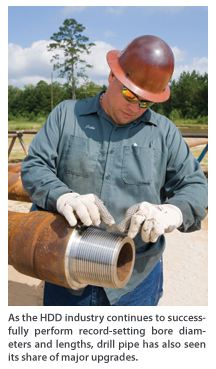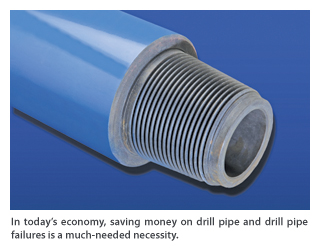Drill Pipe: Technology Upgrades
 It’s not uncommon today to see horizontal directional drilling (HDD) projects that push the envelope of what is considered possible, with ever-deeper and longer bores. As the industry discovers the benefits of HDD, the demands for more depth and length have grown exponentially.
It’s not uncommon today to see horizontal directional drilling (HDD) projects that push the envelope of what is considered possible, with ever-deeper and longer bores. As the industry discovers the benefits of HDD, the demands for more depth and length have grown exponentially.
The result is that companies involved in HDD are looking for pipe and connections that can withstand the torque and load requirements of more complex jobs. And to meet those needs, pipe companies are turning to technology to find solutions.
In fact, there have been several recent technology changes that have helped to enable record-setting bore diameters and lengths. Drill pipe, in particular, has seen major upgrades — for example, the introduction of double shoulder connections and the modified S-135 drill pipe body grade. Not only have innovative designs aided in these drilling applications, but more strict and thorough inspection programs have played a big part in the extended life of drill pipe and its connections.
Increasing Pipe Lifespan with New Technology
Double shoulder connections on drill pipe, subs and other drilling tools are designed to enhance the performance of connections without requiring special running and handling procedures.
Some characteristics that can be seen on double shoulder connections are smaller OD, larger IDs and an approximately 15 to 30 percent increase in torque capacity as compared to standard rotary shouldered connections. In many cases, these double shoulder connections have design features that increase the bending fatigue resistance of the connection.
When the connections are made up properly, the box counter bore is compressed, the pin base elongates elastically and the internal secondary torque shoulders engage. The secondary torque shoulder allows for enhanced load distribution across the threaded region and provides increased torsional capacity when compared to standard rotary shouldered connections. Since the secondary shoulder functions solely as a torque stop and not a pressure seal, minor damage to the shoulder can be tolerated without adversely affecting connection performance.
With the primary and secondary shoulder engaged at the proper make-up torque, the connection shoulders are allowed to remain in contact, which prevents any downhole make-up and/or shoulder separation from tensile and/or bending loads and will also prevent any connection leakage.
The added benefits of the double shoulder connections are enhanced torque, additional OD wear before downgrading the drill string, improved hydraulic efficiencies and interchangeability with most standard connections.
There are also new connections being developed for higher torsional strength, enhanced hydraulics and increased fatigue resistance. For more information on these connections, contact your drill pipe supplier. Study the connections and make sure that there is indeed a benefit from their designs.
Another technical advantage that is now being used in the HDD industry is the grade S-135 pipe, which is now modified with higher Charpy impact strengths. Manufacturers that truly understand the need for higher strength and higher toughness in steel incorporate a proprietary chemistry and rigidly control quench and temper heat treatment processes.
In fact, the minimum Charpy impacts for the modified S-135 are more than 48 percent higher than stated in API specification 5D. The performance behavior resulting from the increase in toughness provides a margin of safety superior to normal high strength material.
Thorough Inspections: Less Costly than Pipe Failure
In today’s economic market, saving money on drill pipe and drill pipe failures is a much-needed necessity. The maintenance and inspection of drill pipe plays a big part in extending the life of the pipe and threads.
As more severe drilling conditions are reached everyday, several factors are combined to make the cost of a potential drill pipe failure very high. So performing a critical inspection on drill pipe and its connections can help catch any substandard drill pipe before it is put back in to service.
 The TH HILL DS-1 CAT5 inspection program was designed for drill pipe grades X-95, G-105 and S-135, which compose API Group 3. The inspection program is intended for drill pipe and drill string components that are to be used in extremely adverse conditions where the potential of a failure is large, as it is in the HDD market.
The TH HILL DS-1 CAT5 inspection program was designed for drill pipe grades X-95, G-105 and S-135, which compose API Group 3. The inspection program is intended for drill pipe and drill string components that are to be used in extremely adverse conditions where the potential of a failure is large, as it is in the HDD market.
The standard covers all of the API RP7G requirements for Premium Class, but includes added dimensional and fluorescent wet magnetic particle inspections on the connection threads. This added inspection follows through to the tube body, where a full-length scanning of the tube, excluding the upset and slip areas, is performed with a unit that has both longitudinal magnetic field EMI and gamma ray wall thickness capabilities. The upset and slip areas are then inspected using both magnetic particle inspection and ultrasonic wall thickness testing to ensure a defect-free area.
DS-1 CAT5 not only covers the physical product inspection, but also maintains firm requirements on inspection process quality control and requirements on the calibration and use of the inspection equipment.
This additional scrutiny does increase the price of pipe inspections. In most cases, this added value as compared to an API “Standard Rack Inspection” or its equivalent DS-1 CAT3 inspection is approximately 36 percent.
It’s clear that as the HDD industry matures and pursues ever-more difficult projects, engineering and quality will need to respond with ingenuity and creativity to develop the tools that can get the job done.
Cain Pacheco is director of engineering for HDD Rotary Sales LLC of Houston.
